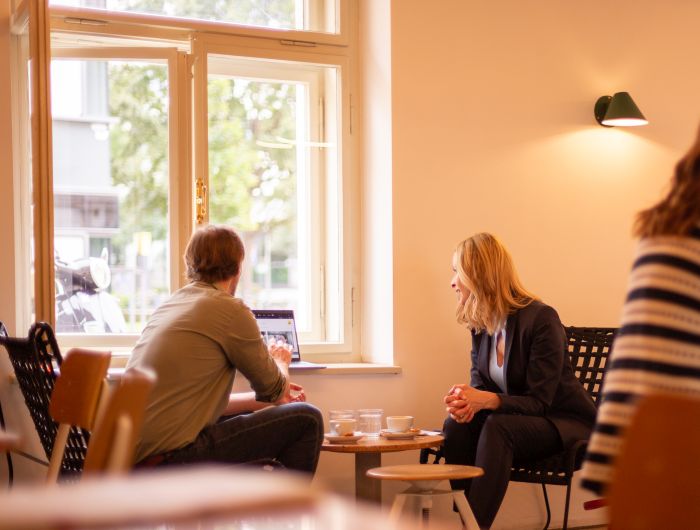About students' conceptual understanding of climate change

Claudia Haagen-Schützenhöfer is a university professor for physics education research at the University of Graz. She is the only Austrian professor of education research in physics. Before taking up her professorship, she worked for 8 years as a teacher in the subjects physics, English, science laboratory and project management at different Styrian secondary schools.
With more than 200 scientific publications from the last 13 years, Claudia Haagen has an excellent international reputation in the field of empirical research-based physics education research.
In a current research focus, she has, for example, developed a test instrument, the Concept-Inventory CCCI-422 on the scientific foundations of climate change, together with colleagues Thomas Schubatzky (now at the University of Innsbruck) and researchers from the University of Bochum (Germany), which can provide information about the conceptual understanding of learners from the 8th grade onwards on the scientific foundations of global climate change.
If you follow the media discourse on climate change, you get the impression that the topic is very complex and the connections are difficult to grasp at first glance. Even experts often disagree and controversial views are emerging in the media landscape. Under these conditions, how can students and young people in general be introduced to the topic as well as the scientific principles of climate change in an evidence-based manner?
Claudia Haagen-Schützenhöfer: Climate and climate change are definitely very complex topics. Physics lessons typically revolve around linear causal relationships along the lines of "If I exert force X, it will affect the movement of an object in one way or another". Even such relationships are not always so easy for students to understand, internalize, and apply. Climate is generally a complex system, which is why there is not THE one solution to the challenges posed by current climate change. It is virtually impossible to get through all of the complexity in the classroom. But complexity and variability are also characteristics of scientific knowledge, along with reliability, and this is something that students should and must understand so that they do not fall victim to scientific skepticism and can make their own decisions. In the context of climate change, it is crucial that students understand that the vast majority of climate scientists, i.e., more than 97%, agree on the causes of the current climate change; namely that it is largely man-made. There is a broad consensus on this, even though climate change deniers often try to make us believe otherwise through various channels.
What contribution can teaching make here to make it easier for students to recognize fake news, denial strategies, etc.?
Claudia Haagen-Schützenhöfer: It is important that students understand the basic physical concepts related to climate change so that they do not fall for the arguments of climate change skeptics. Here, unbelievable means are really being used and manipulated. Students also need to know about these pitfalls of the distorting and manipulating portrayal of science and scientists, which are also fueled by social media. Only then can they recognize these mechanisms and counter them in a professionally sound manner. Together with my colleague Thomas Schubatzky, I am conducting research in this area. In 2020, we conducted a study with Austrian young people on climate change disinformation - based on a study with adults in the USA. The so-called "Oregon Petition" was used. This is a disinformation campaign aimed at confusing the public about findings in climate science and the scientific consensus on human-caused global warming. It was pretended that the petition, which was signed over 31,000 times, was supported by experts who deny the existence of man-made climate change. A closer analysis showed that scientists with relevant expertise were only represented in the per mille range, but many supporters signed several times and also joke entries, such as the Spice Girls, Charles Darwin (1882 deceased) or characters from Star Wars, were among the signers.
Incidentally, the more than 1,000 young people we surveyed strongly agree that current climate change is man-made. When asked how much scientists agree on this, the young people clearly underestimate the consensus within the scientific community.
From which school level should and can students deal with the topic of "climate change" in class?
Claudia Haagen-Schützenhöfer: Since the majority of Austrian students leave the formal school system after the 9th grade, it was very important to my colleague Martin Hopf from the University of Vienna and me to prominently include the topic of climate and climate change in the development of the new curriculum for the lower secondary level. Students should be able to develop a basic understanding of the concepts and mechanisms involved and have the opportunity to discuss what concerns them in this context. Physics lessons should enable them to critically reflect on different positions and to contribute their own perspective to the social discourse, but also to show individual options for action, i.e., what each individual can contribute.

Through initiatives and movements such as "Friday for Future" and the "Last Generation," young people's interest in climate change seems to have risen sharply - especially in how it affects their own generation. With great commitment, they are drawing media attention to the consequences and calling for swift action from politicians and society to halt the advance of climate change. What influence do these initiatives have on young people's awareness of global climate change and its scientific foundations and interrelationships?
Claudia Haagen-Schützenhöfer: What initiatives like "Fridays for Future" do with young people and the commitment involved is truly remarkable! Movements of this kind naturally raise awareness of the issue not only among young people, but also in the media and thus in society as a whole. However, I would not want to see the role of knowledge transfer primarily in these movements. Schools must undertake central responsibility here. As already mentioned, the young people in our replication study, for example, significantly underestimated the consensus on anthropogenic climate change within the scientific community. However, this perceived consensus on a topic is a very central factor for public perception; we experienced this during the Covid pandemic, among other things. This brings us back to the important role of schools, which must educate students so that they have a basic understanding of the content and understand how science works; but also to know about attitudes, so that a fact-oriented, reflective participation in public discourse is possible.
Compared to previous generations, can we see increased knowledge in this area in the classroom?
Claudia Haagen-Schützenhöfer: As far as knowledge about climate and climate change is concerned, we cannot say whether and how this has changed, as there are no comparative surveys. However, studies from German-speaking countries show that students are not really well prepared in this area. However, if one assumes that this topic hardly appears in the curricula, the students actually know more about it than one would expect. Of course, anecdotal evidence from the number of initiatives, the media presence, or the demand for teaching materials or training courses on the subject suggests that there is great interest and demand among teachers and students. In our personal perception, a great deal has happened here in recent years. However, students get most of their knowledge about climate change from social media rather than from school.
The Covid pandemic, economic instability, and climate change. Students are growing up in uncertain times. Above all, the effects of global climate change are a challenge that must be overcome. In the (social) media, one can find easily accessible information about this, which does not always correspond to the truth. How do (social) media influence students' perceptions of climate change and their willingness to act?
Claudia Haagen-Schützenhöfer: Social media have an enormous influence on students. We know that digital and social media are one of the main sources of reference for young people. Naturally as well as renownedly, the innovation that digitality brings (i.e., that everyone not only has the opportunity to participate in the discourse, but can also slip into the role of a creator) also has negative effects. The typical direction of science communication no longer works, i.e., from the scientist via science journalists, who fulfill a kind of gatekeeper function, to the public. Social media act as a kind of detour, which makes communication challenging. Students need this understanding of digitality in the sense of referentiality, algorithmicity, and social participation so that they can participate critically and reflectively in the digital knowledge society. It is not enough to equip schools with mobile devices. They need well-prepared teachers. In the ProDigiTrans project, we are currently developing such learning opportunities for (prospective) science teachers.

Together with researchers, you have developed a test instrument, the Concept Inventory CCCI-422, which is designed to assess students' conceptual understanding of the scientific basis of climate change. What motivated you and your colleagues to launch this project?
Claudia Haagen-Schützenhöfer: We started the idea in 2019 after we decided at an international conference with a colleague from a German university that we, as researchers, also wanted to make a concrete contribution to this topic and to sustainable climate change education. Actionism does not help us here. If it is to be effective, climate change education must be based on research results. You can perhaps imagine that the development of a psychometrically reliable test instrument is relatively complex and costly. Typically, to make it easier to imagine, one can say that such a development takes the scope of a dissertation project, i.e., about 3-4 years.
What is the Concept Inventory (CCCI-422)?
Claudia Haagen-Schützenhöfer: The Concept Inventory (CCCI-422) is a multiple-choice test instrument with 36 items that assesses the understanding of students and student teachers in five subject areas. These are weather & climate, climate as a system, carbon cycle, greenhouse effect, and atmosphere. In selecting the topics, we drew on previous research and conducted interviews with climate experts from Austria and Switzerland. So far, the instrument has been tested on about 800 pupils and 50 physics students. The results show that there is no adequate understanding of the technical basics of climate change. We are currently using the findings of the test surveys in a cooperation with the University of Innsbruck, where, among other things, initial teaching modules for the lower school are being developed on the basis of research within the framework of a dissertation.
What are the goals of this study?
Claudia Haagen-Schützenhöfer: We developed the test instrument in order to obtain reliable evidence about the understanding of the basic subject-related concepts of students, but also student teachers, on the topic of climate and climate change, how the lessons must be structured according to these prerequisites, and how well developed materials function. I cannot say this often enough: We need empirical evidence when it comes to learning prerequisites and learning processes. This is quite self-evident in other areas, but in schooling and education, it has not yet reached everyone involved. Imagine you had a leg injury and instead of having an X-ray or the like done, for example, the doctor would operate on you right away or put a cast on you without having examined you comprehensively beforehand and without also doing a follow-up examination at a later time. You would most likely consider this approach to be less than reputable. Transferred to school and education, materials, methods or workshops etc. are often developed in this field without looking at the initial situation or the initiated learning processes themselves with resilient methods. At the end of the workshop, for example, everyone goes home and is happy because something has happened. Whether the learning processes have really run as intended and what has been achieved in the long term is rarely known for sure. This is where we, as empirically researching subject didactics, come in and provide teachers with concepts that offer assistance in the development and evaluation of goal-oriented interventions in the context of learning processes.

In your opinion, what contribution can each individual make to counteract climate change?
Claudia Haagen-Schützenhöfer: In my view, there are two areas that come into play here. On the one hand, the avoidance and reduction of all those things that we know are not climate-friendly and leave a large ecological or CO2 footprint, such as in transportation and mobility, energy efficiency in the household, nutrition as well as consumption. On the other hand, by actively addressing the issue by thinking outside the box, staying informed, and participating in the public discourse; e.g., in the community where one lives or among friends and acquaintances. Climate change is a problem for society as a whole. The consequences affect us all, as we are increasingly experiencing
Paper - Development of the Concept-Inventory CCCI-422 on the scientific basis of climate change.